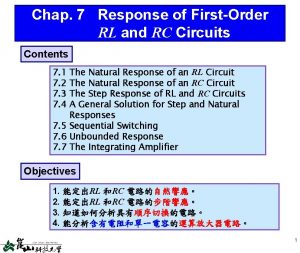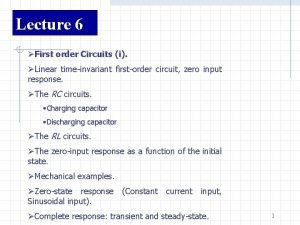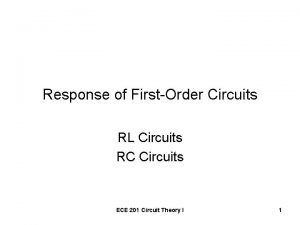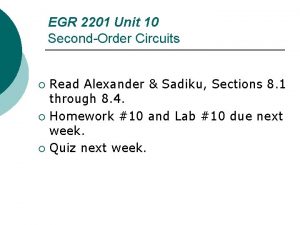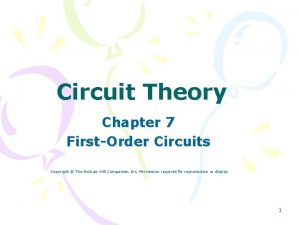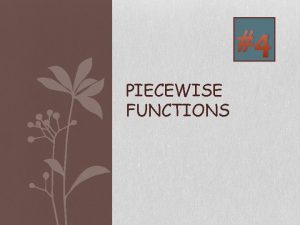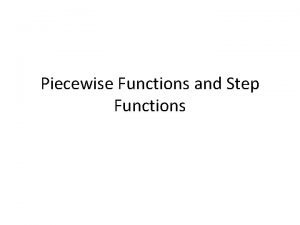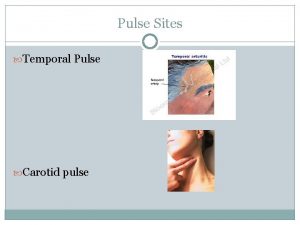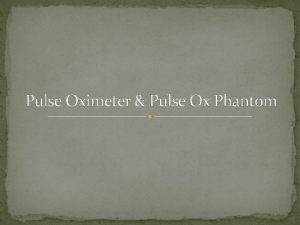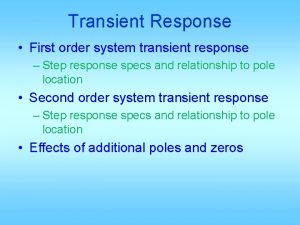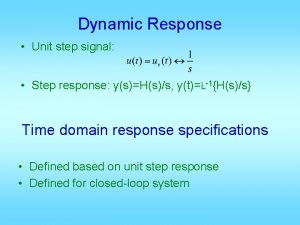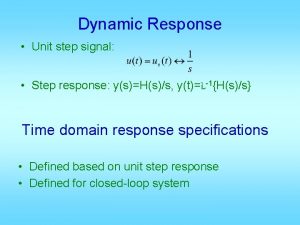Pulse Response First Order Circuits Unit Step functions









- Slides: 9

Pulse Response - First Order Circuits Unit Step functions, Pulse Sources, and SPICE Kevin D. Donohue, University of Kentucky 1

The Unit Step Function The unit step function models the behavior of a switch (i. e. off-on) and can be used to describe more complex circuit sources. ØMultiplying u(t) by a constant changes the value of u(t) for t > 0. ØSubtracting a positive number from the argument of u(t) shifts the step in the positive t direction. ØAdding step functions together results in piece-wise steps with the resultant values equal to the sum of step values in each t interval. Kevin D. Donohue, University of Kentucky 2

Example Determine the unit step response for io(t) the circuit below with input vs(t) = u(t): Show: Kevin D. Donohue, University of Kentucky 3

The Unit Pulse Function The unit pulse function is defined as : It can be expressed in terms of a combination of unit step functions: Kevin D. Donohue, University of Kentucky 4

The Unit Ramp Function The unit ramp function is defined as : It can be expressed as the integral of the unit step: Kevin D. Donohue, University of Kentucky 5

The Unit Impulse Function The unit impulse function is defined as : It can be expressed as the derivative of the unit step: Note that: Kevin D. Donohue, University of Kentucky 6

Example Determine the pulse response for io(t) the circuit below with input vs(t) = 40 v(t) V, where pulse duration T is 2 ms: Show: Kevin D. Donohue, University of Kentucky 7

SPICE Simulation with Step Source Do a SPICE Simulation to determine the pulse response for io(t) the Previous circuit with input vs(t) = 40 v(t) V, where pulse duration T is 2 ms: Ø To solve you must do a transient analysis, define the voltage source as piece-wise linear, and describe its transient properties. tranex-Transient-14 -Table TIME I(VAM) (s) (Amp) +0. 000 e+000 +10. 000 n +99. 999 n +10. 840 n +109. 104 n : : : +7. 285 m +972. 534 u +7. 445 m +795. 710 u +7. 605 m +651. 035 u +7. 765 m +532. 665 u +7. 925 m +435. 817 u +8. 000 m tranex-Transient-14 (Amp) +0. 000 e+000 +2. 000 m +4. 000 m Time (s) +6. 000 m +8. 000 m +500. 000 m +396. 630 u +0. 000 e+000 I(VAM) Kevin D. Donohue, University of Kentucky 8

SPICE Simulation with Switch Do a SPICE Simulation to determine the pulse response for io(t) the circuit below with input vs(t) = 40 V, where pulse duration T is 2 ms: Ø To solve you must do a transient analysis, define auxiliary circuits for voltage sources and meters that control the opening and closing of the switches. (Amp) Kevin D. Donohue, University of Kentucky 9

